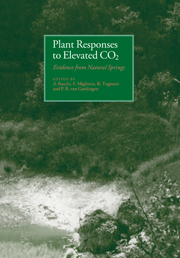Book contents
- Frontmatter
- Contents
- List of contributors
- Preface
- Sites of naturally elevated carbon dioxide
- Migration in the ground of CO2 and other volatile contaminants. Theory and survey
- Levels of CO2 leakage in relation to geology
- CO2 emission in volcanic areas: case histories and hazards
- Controlled degassing of lakes with high CO2 content in Cameroon: an opportunity for ecosystem CO2-enrichment experiments
- Burning coal seams in southern Utah: a natural system for studies of plant responses to elevated CO2
- Long-term effects of enhanced CO2 concentrations on leaf gas exchange: research opportunities using CO2 springs
- Using Icelandic CO2 springs to understand the long-term effects of elevated atmospheric CO2
- Plant CO2 responses in the long term: plants from CO2 springs in Florida and tombs in Egypt
- Acidophilic grass communities of CO2 springs in central Italy: composition, structure and ecology
- Studying morpho-physiological responses of Scirpus lacustris from naturally CO2-enriched environments
- Carbon physiology of Quercus pubescens Wild, growing at the Bossoleto CO2 spring in central Italy
- Preliminary results on dissolved inorganic 13C and 14C content of a CO2-rich mineral spring of Catalonia (NE Spain) and of plants growing in its surroundings
- The impact of elevated CO2 on the growth of Agrostis canina and Plantago major adapted to contrasting CO2 concentrations
- Stomatal numbers in holm oak (Quercus ilex L.) leaves grown in naturally and artificially CO2-enriched environments
- Effects of CO2 on NH4+ assimilation by Cyanidium caldarium, an acidophilic hot springs and hot soils unicellular alga
- Can rising CO2 alleviate oxidative risk for the plant cell? Testing the hypothesis under natural CO2 enrichment
- Increasing concentrations of atmospheric CO2 and decomposition processes in forest ecosystems
- Index
Plant CO2 responses in the long term: plants from CO2 springs in Florida and tombs in Egypt
Published online by Cambridge University Press: 10 February 2010
- Frontmatter
- Contents
- List of contributors
- Preface
- Sites of naturally elevated carbon dioxide
- Migration in the ground of CO2 and other volatile contaminants. Theory and survey
- Levels of CO2 leakage in relation to geology
- CO2 emission in volcanic areas: case histories and hazards
- Controlled degassing of lakes with high CO2 content in Cameroon: an opportunity for ecosystem CO2-enrichment experiments
- Burning coal seams in southern Utah: a natural system for studies of plant responses to elevated CO2
- Long-term effects of enhanced CO2 concentrations on leaf gas exchange: research opportunities using CO2 springs
- Using Icelandic CO2 springs to understand the long-term effects of elevated atmospheric CO2
- Plant CO2 responses in the long term: plants from CO2 springs in Florida and tombs in Egypt
- Acidophilic grass communities of CO2 springs in central Italy: composition, structure and ecology
- Studying morpho-physiological responses of Scirpus lacustris from naturally CO2-enriched environments
- Carbon physiology of Quercus pubescens Wild, growing at the Bossoleto CO2 spring in central Italy
- Preliminary results on dissolved inorganic 13C and 14C content of a CO2-rich mineral spring of Catalonia (NE Spain) and of plants growing in its surroundings
- The impact of elevated CO2 on the growth of Agrostis canina and Plantago major adapted to contrasting CO2 concentrations
- Stomatal numbers in holm oak (Quercus ilex L.) leaves grown in naturally and artificially CO2-enriched environments
- Effects of CO2 on NH4+ assimilation by Cyanidium caldarium, an acidophilic hot springs and hot soils unicellular alga
- Can rising CO2 alleviate oxidative risk for the plant cell? Testing the hypothesis under natural CO2 enrichment
- Increasing concentrations of atmospheric CO2 and decomposition processes in forest ecosystems
- Index
Summary
SUMMARY
Seeds were collected from populations of Boehmeria cylindrica growing in naturally enriched concentrations of CO2. In the controlled environment plants grown from populations which are normally exposed to enriched atmospheres of CO2 (400 to 575 ppmv) show a greater CO2-sensitivity of growth than plants from ambient (370 ppmv) sites. Observed differences in height growth and dry weight partitioning could be explained in terms of the different rates of plant growth under the imposed treatments, rather than in terms of population differences in growth partitioning. Comparisons of stomatal density-CO2 responses for species from different climates and over the different time scales of centuries and millennia indicate a similar decline in density with increasing CO2 concentrations, with no evidence of any changes in the CO2 sensitivity. However, the clear species-specific nature of the stomatal density response suggests it is unlikely to be observed ubiquitously in plants growing by high-CO2 springs. Nevertheless, there is a close similarity between the stomatal density responses shown by plants growing under CO2 enrichment adjacent to springs, and the stomatal density changes recorded from fossil leaves, indicating one valuable use of high-CO2 springs in biological research.
INTRODUCTION
Measurements of the atmospheric concentration of CO2, typically from air locked up in permanent ice caps, provide time courses for a continuously varying CO2 concentration over the last 160,000 years (Barnola et al., 1987). Estimates of CO2 by indirect means also show variations of CO2 concentration over millions of years (Hays, Imbrie & Shackleton, 1976; Berner, 1990).
An interesting consequence of these variations is the potential for a CO2-controlled selection in higher plants.
- Type
- Chapter
- Information
- Plant Responses to Elevated CO2Evidence from Natural Springs, pp. 103 - 113Publisher: Cambridge University PressPrint publication year: 1997
- 1
- Cited by



